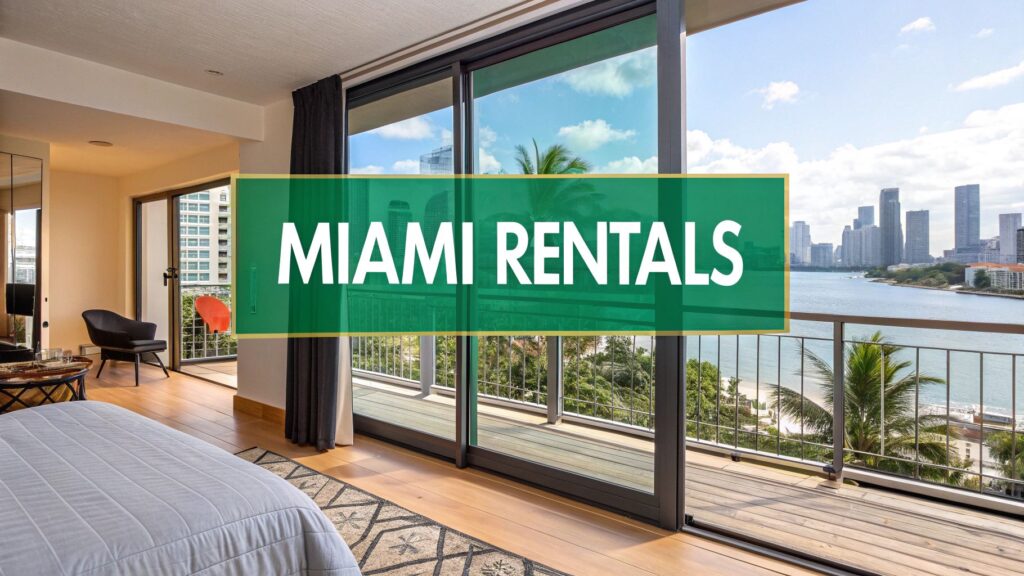If you’re looking for 1 bedroom apartments for rent in Miami, you’re jumping into a fast-paced, competitive market. Prices can swing wildly from one neighborhood to the next. While the median rent for a one-bedroom hovers around $2,600, that number is just a starting point. Your final cost really depends on how close you want to be to the beach, what kind of amenities you’re after, and the overall vibe of the neighborhood you land in.
What to Expect in the Miami Rental Market
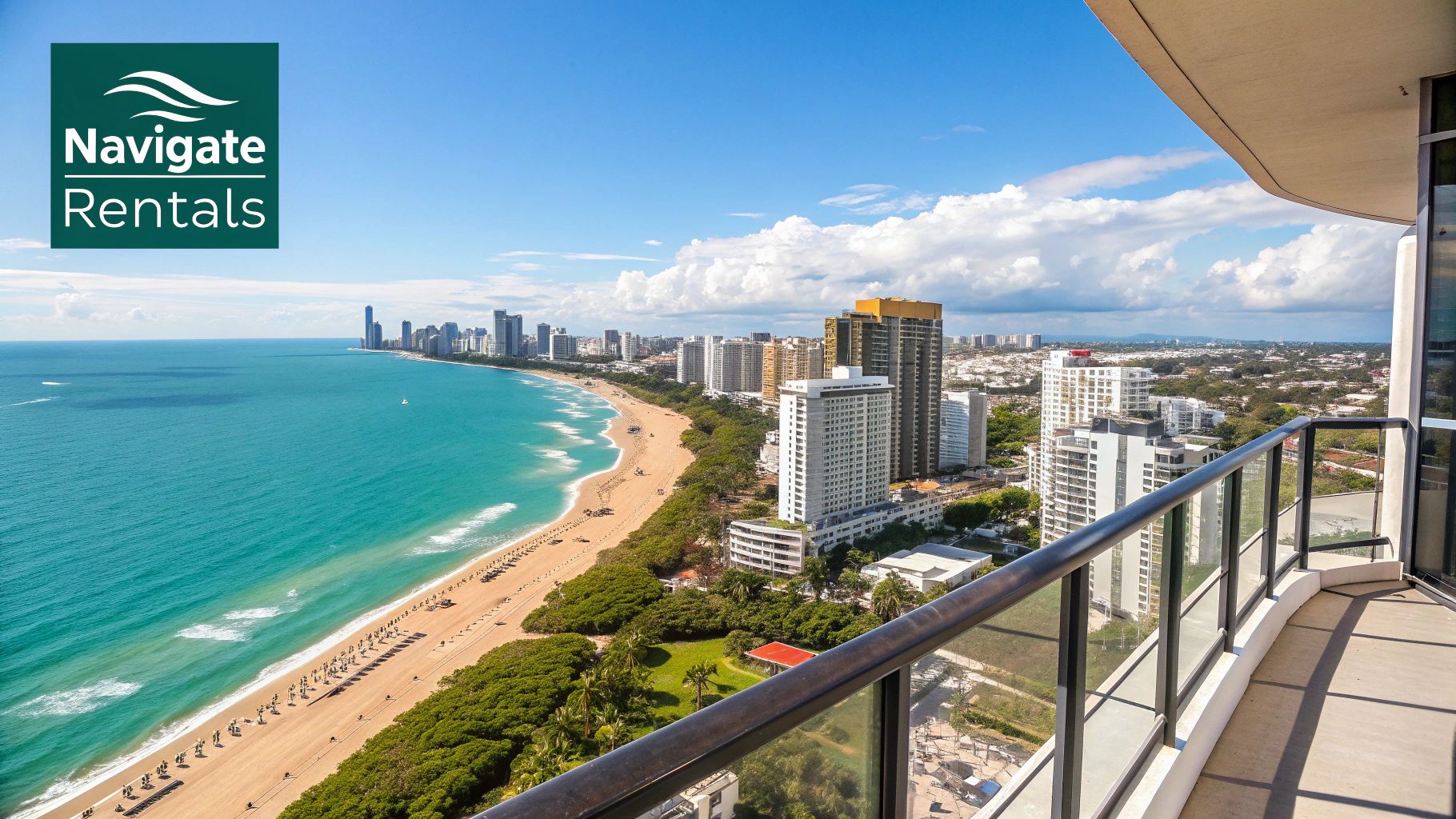
Searching for your perfect spot in Miami is a genuine adventure, but it pays to know what you're up against. The best way to think about the rental market is as its own ecosystem—where location, building quality, and amenities all dictate the price and availability of apartments. A unit in the high-energy financial district of Brickell is going to offer a completely different experience—and price tag—than a laid-back place in Coconut Grove.
Miami's rental landscape is always in motion. We've recently seen an interesting tug-of-war between supply and demand. Even as the overall median rent in the city has cooled off a bit, the hunger for smaller units is as strong as ever.
A Zumper rental market analysis actually showed that one-bedroom apartments saw their median rent increase by 6%, hitting that $2,600 mark. For renters, this tells a crucial story: the broader market might be stabilizing, but the competition for a great one-bedroom is still very real.
Key Factors Shaping Rental Prices
So, what actually goes into the final price of a one-bedroom apartment? Getting a handle on these factors gives you a huge advantage in your search. Knowing these variables is a great starting point, and you can get even more prepared by learning the ins and outs of the apartment rental process in Miami.
Here are the main things driving the costs:
- Neighborhood Popularity: Hotspots like South Beach, Brickell, and Wynwood will always cost more. You're paying a premium for the nightlife, walkability, and access to major employers.
- Building Amenities: This is a big one. A building with a rooftop pool, a modern gym, and a 24-hour concierge will have a much higher rent than a complex with more basic offerings.
- Proximity to the Ocean: It’s no surprise that apartments with ocean views or those just a short walk from the beach are some of the most expensive. You’re paying for that iconic Miami lifestyle.
- Age and Condition: Brand-new buildings with sleek finishes, smart home tech, and hurricane-impact windows naturally command higher rents than older properties that haven't been updated.
At the end of the day, finding the right apartment is all about striking a balance between your budget and your lifestyle. The real key is knowing what you’re willing to compromise on and what’s a non-negotiable, whether that’s a shorter commute, easy beach access, or a touch of luxury.
Keeping these factors in mind helps you build a smart, focused search strategy. With this knowledge, you can zero in on the neighborhoods and properties that actually fit your budget and your vision for living in this incredible city.
Budgeting for Your Miami Apartment Lifestyle
Finding a one-bedroom apartment in Miami is an exciting prospect, but let's be real—your budget is what makes or breaks the deal. It's easy to get caught up in the sticker price of the rent, but that's just the tip of the iceberg.
Think of it this way: when you plan a trip, you don't just budget for the flight. You have to factor in hotels, food, and activities to get a true sense of the cost. Apartment hunting is the exact same. The advertised rent is your starting point, not the finish line.
To avoid any nasty surprises down the road, you need a solid financial game plan. This means getting a handle on both the one-time costs to get your keys and the ongoing monthly expenses that come with living the Miami life. A well-thought-out budget means you can actually enjoy your new place without constantly worrying about money.
Tallying Up the Initial Costs
Before you even start unpacking boxes, you'll need to be ready for a few significant upfront payments. Landlords in Miami require these to secure the apartment and cover their own risk. These fees are usually due all at once when you sign the lease, so having the cash ready is non-negotiable.
- Security Deposit: This is standard practice. Expect it to be equal to one month's rent. You'll get it back when you move out, as long as you leave the place in good shape.
- First and Last Month's Rent: This one catches a lot of people off guard. Many landlords here ask for the first and last month's rent upfront, on top of the security deposit. So for a $2,500 apartment, you could be looking at a $7,500 payment right out of the gate.
- Application and Admin Fees: These are smaller, non-refundable fees that cover background checks and paperwork. Budget anywhere from $50 to $150 per applicant.
Planning for Recurring Monthly Expenses
Once you're in, your financial responsibilities shift to the ongoing costs. These are the expenses that will hit your bank account every single month, and they can add up faster than you'd think.
Let's not sugarcoat it: renting in Miami is expensive. As of late last year, the average rent for a one-bedroom was sitting around $2,180 a month, which blows the national average of $1,630 out of the water. Head into a hot neighborhood like Brickell, and that average can soar past $4,100. This keeps Miami's overall rental market a steep 55% above the national median. You can dig into these numbers and explore more detailed Miami rent trends to see how different neighborhoods stack up.
To give you a better idea of where your money will go, check out this breakdown of typical monthly costs for a Miami one-bedroom.
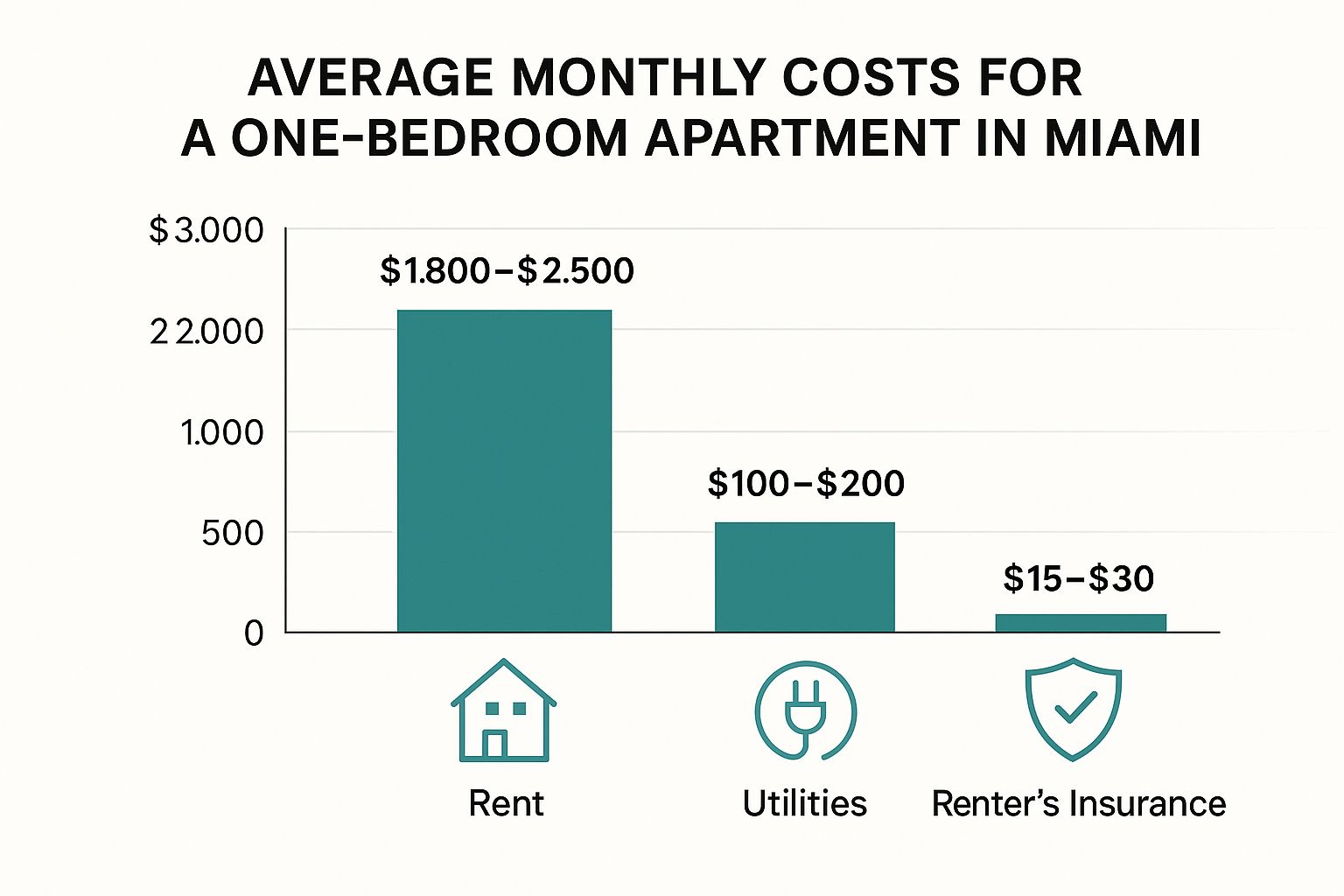
As you can see, utilities and other fees can easily tack on a few hundred dollars to your base rent every month.
Key Takeaway: A great rule of thumb is the 30% rule. Your total housing costs—rent plus all those extra monthly fees—shouldn't be more than 30% of your gross monthly income. Sticking to this helps ensure you have enough cash left over for everything else life throws at you.
Breaking Down Your Monthly Budget
To create a budget that actually works, you need to account for all the little things. Here are the most common recurring costs you'll face when looking for 1 bedroom apartments for rent in Miami.
- Utilities: That famous Florida sunshine comes with a price—your AC bill. Plan on $100 to $200 a month for electricity alone. Water, sewer, and trash will probably add another $50 to $80.
- Parking: A dedicated parking spot is gold in this city. In busy areas like Downtown or South Beach, you could pay anywhere from $150 to $250 a month just for a place to put your car.
- Renter's Insurance: Most landlords require it, and honestly, you should have it anyway. It protects your stuff and provides liability coverage for a small monthly fee, usually $15 to $30.
- Amenity Fees: Love the idea of a rooftop pool and a state-of-the-art gym? So do the landlords. Many luxury buildings charge a mandatory monthly fee of $25 to $75 for access to these perks.
- Internet and Cable: A modern-day necessity. Depending on the speed and package you choose, this will set you back between $60 and $120 a month.
By adding these estimates to your target rent, you get a much more accurate picture of your true monthly housing cost. This is how you find an apartment that doesn't just look good, but actually fits your budget and lets you live comfortably.
Exploring Miami's Top Neighborhoods
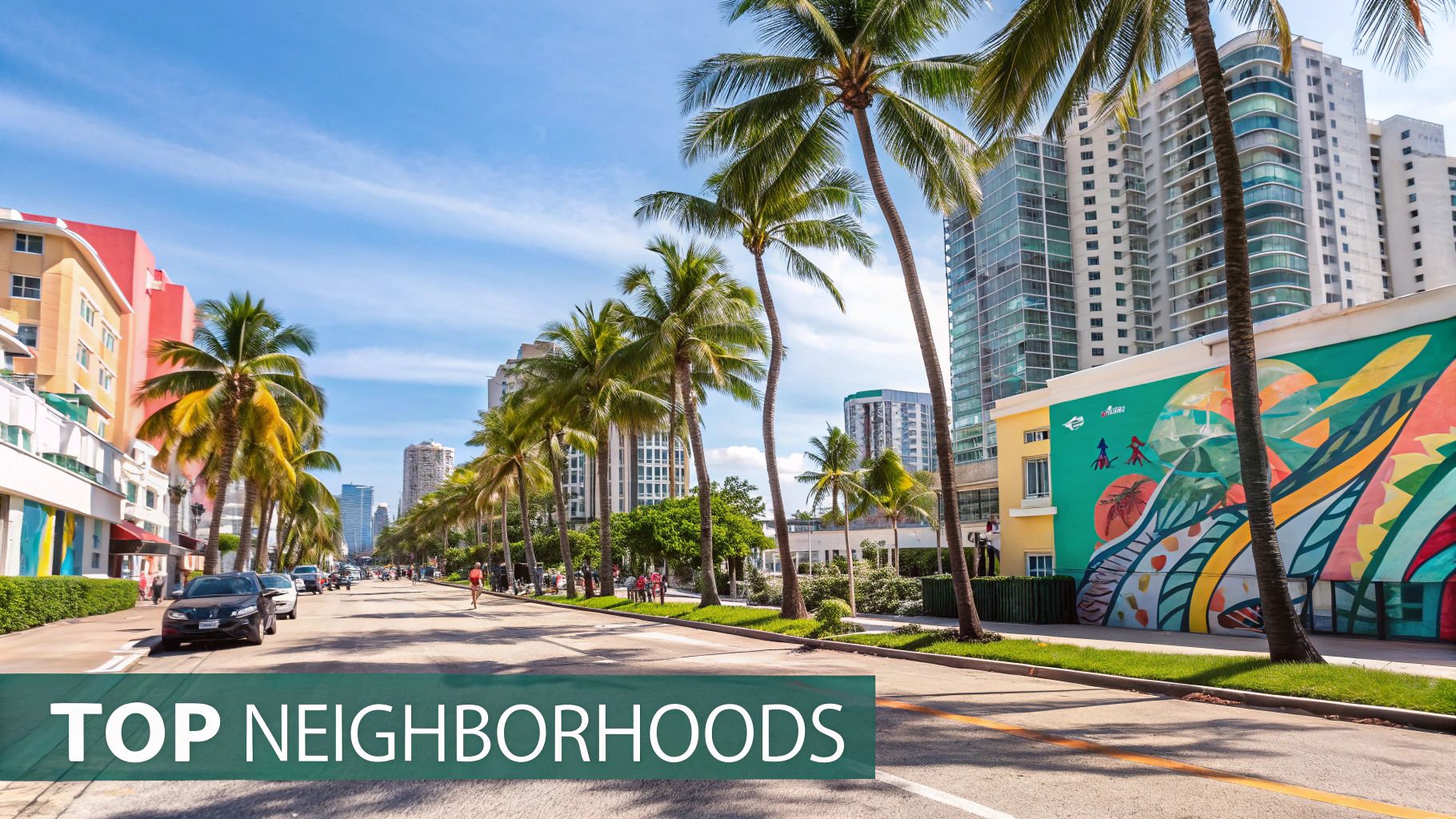
Choosing a neighborhood in Miami is less about picking a spot on a map and more about deciding who you want to be. Each area has its own rhythm, its own culture, and its own price tag. Finding the right fit is all about matching your lifestyle and your budget to the unique personality of the place.
This isn’t just about finding an address; it’s about finding your community. Whether you're chasing the electric energy of the city's core or the laid-back vibe of a beachside community, your ideal one-bedroom apartment is out there waiting in a neighborhood that truly feels like home.
H3: Brickell and Downtown: The Urban Powerhouses
Ever imagine living where the city’s heart beats the loudest? That's Brickell and Downtown. This is Miami's financial district, a concrete canyon of gleaming high-rises that promises a life of ambition and convenience. It’s built for professionals who want their work, social life, and home to exist within a few walkable blocks.
Life here is fast and vertical. Your favorite coffee shop, your office, and your go-to happy hour spot might all be in the same building. The price for this kind of walkability and prestige? It’s steep.
These are, without a doubt, some of Miami’s most expensive zip codes. We're talking about average one-bedroom rents in Brickell easily pushing past $4,000. Even as the broader rental market cools down, the demand for this high-octane lifestyle keeps prices firm. You can see how these areas stack up against others in this Miami apartment rent trends analysis.
H3: Wynwood and The Design District: Creative and Chic Hubs
If you're more drawn to art galleries than boardrooms, then Wynwood and the Design District are your sanctuaries. Wynwood is a world-famous canvas of street art, buzzing with trendy breweries and one-of-a-kind shops. The energy here is young, creative, and always evolving.
Just a short walk away, the Design District offers a more polished, high-fashion version of creativity. It’s a curated world of luxury showrooms, mind-bending architecture, and high-end restaurants. Together, they form Miami’s cultural core, drawing in artists, designers, and anyone with an eye for aesthetics.
Renting a one-bedroom here means living and breathing creativity.
- Wynwood: Think converted warehouses and cool, modern low-rises. The vibe is industrial-chic—perfect for someone who loves an authentic, gritty feel and a vibrant social scene.
- Design District: Here you’ll find sleeker, more contemporary apartments. It's generally quieter than Wynwood but puts world-class shopping and art right at your doorstep.
Choosing between them is like picking your preferred artistic medium. Wynwood is the raw, energetic street artist; the Design District is the refined, minimalist sculptor. Both offer a living experience you simply can’t find anywhere else.
H3: South Beach and Mid-Beach: The Iconic Coastal Escapes
For most people, the word "Miami" conjures up images of sun, sand, and sparkling blue water. South Beach and Mid-Beach are where that postcard image comes to life. Living here means the Atlantic Ocean is your front yard, giving you a permanent vacation vibe that’s hard to beat.
South Beach is legendary for its Art Deco charm, non-stop nightlife, and, of course, its world-famous shoreline. It’s a 24/7 playground, perfect for socialites and beach bums who crave being in the middle of all the action.
Mid-Beach offers a slightly more relaxed version of coastal living. You still get the beautiful beaches and luxury high-rises, but with a calmer, more residential feel. It's a great compromise for those who want to wake up to ocean views without the constant buzz of South Beach. The famous Miami Beach Boardwalk connects them both, so you’re never far from the best of either world. Deciding on the right apartment in Miami, Florida often starts with figuring out just how close to this iconic coastline you want to be.
To give you a clearer picture, here’s a quick breakdown of what you can expect to pay for a one-bedroom apartment across some of these key neighborhoods.
Miami Neighborhood One Bedroom Rent Comparison
| Neighborhood | Average 1-BR Rent Range | Best For |
|---|---|---|
| Brickell / Downtown | $3,500 – $4,500+ | Ambitious professionals and city lovers |
| Wynwood | $2,800 – $3,600 | Artists, creatives, and social butterflies |
| South Beach | $2,500 – $3,800 | Beach lovers and nightlife enthusiasts |
| Mid-Beach | $2,400 – $3,500 | Those seeking a quieter oceanfront lifestyle |
This table is just a snapshot, but it highlights how much location impacts your budget. The prestige of Brickell commands a premium, while a bit more affordability can be found if you prioritize a creative or coastal vibe.
H3: Finding Your Perfect Neighborhood Fit
At the end of the day, the "best" neighborhood is an incredibly personal decision. To figure out where you belong, ask yourself a few honest questions.
- Budget: What is the absolute highest number you can comfortably write on a rent check each month?
- Commute: How much of your life are you willing to spend getting to work or school?
- Lifestyle: Are you looking for a quiet, residential street or a place where there's always something going on?
- Walkability: Is it a deal-breaker if you can't walk to a coffee shop, grocery store, or park?
Answering these will help you filter out the noise and zero in on the few areas that genuinely fit your life. This targeted approach is the smartest way to find 1 bedroom apartments for rent in Miami that you’ll be thrilled to call home.
Securing Your Ideal Miami Rental
In Miami's fast-paced rental market, being prepared isn't just an advantage—it's everything. Think about it: the minute you find that perfect 1 bedroom apartment for rent in Miami, you can bet dozens of other people have spotted it too. The renter who gets the keys is almost always the one who was ready to act instantly.
This isn't a game of chance; it's a game of strategy. When you have all your documents organized and ready to go, you immediately jump to the front of the line. You're no longer just looking; you're a serious applicant, and that’s exactly what landlords and property managers want to see.
Assembling Your Rental Application Toolkit
Before you even start touring apartments, your first move should be to get your paperwork in order. I recommend creating both a digital folder on your computer and a physical one you can bring with you. This simple step empowers you to apply on the spot, a decisive action that can make all the difference when multiple applications land on the same day.
Here's a checklist of what you'll need to have ready:
- Proof of Income: This is the big one. Landlords are looking for a gross monthly income that's at least three times the monthly rent. The best way to prove this is with your last two or three pay stubs. If you’re starting a new job, an official offer letter will work. For the self-employed, have your last two years of tax returns handy.
- Government-Issued Photo ID: You’ll need a clear copy of a driver’s license or passport for every adult planning to live in the apartment. No exceptions here.
- Credit Report: The landlord will definitely run their own credit check (and you'll pay for it with the application fee), but bringing your own recent copy shows you're transparent. It also gives you a chance to get ahead of any potential issues and explain them on your own terms.
- References: Put together a list of names and contact information for previous landlords, work supervisors, or even colleagues who can vouch for you. Just make sure you ask for their permission first!
Think of your application as your rental resume. It’s your chance to make a great first impression and show a landlord that you're the most qualified, responsible, and low-risk person for their property. A complete, organized package says a lot before you even have to.
Understanding Your Lease Agreement
Once your application gets the green light, you’ll be handed the lease. This is a legally binding contract, and it's often packed with dense legal language. The biggest mistake you can make is to just skim it and sign. You absolutely have to take the time to read every single clause. What you sign dictates your rights and responsibilities for the next year or more.
Pay very close attention to these key sections:
- Security Deposit Clause: Know the exact dollar amount, where the money will be held, and—most importantly—the exact conditions for getting it back when you move out. Florida law is specific about this, but your lease will outline the rules for that particular property.
- Maintenance and Repairs: The lease needs to spell out who is responsible for what. If the air conditioning dies in the middle of August, who do you call? Are you on the hook for changing air filters and lightbulbs? Get familiar with the process before you actually need it.
- Pet Policy: If you have a furry friend, this section is non-negotiable. Read it carefully for details on pet rent, extra deposits, and any restrictions on breeds or weight.
- Early Termination Clause: Life is unpredictable. You need to know the financial penalties and the required steps if you have to break your lease. This clause can save you thousands of dollars if a sudden job change or family emergency forces you to move.
By taking the time to review these details, you’re not just signing a piece of paper. You're entering into an agreement with your eyes wide open, setting yourself up for a rental experience that’s as sunny as Miami itself.
Choosing Amenities That Match Your Lifestyle
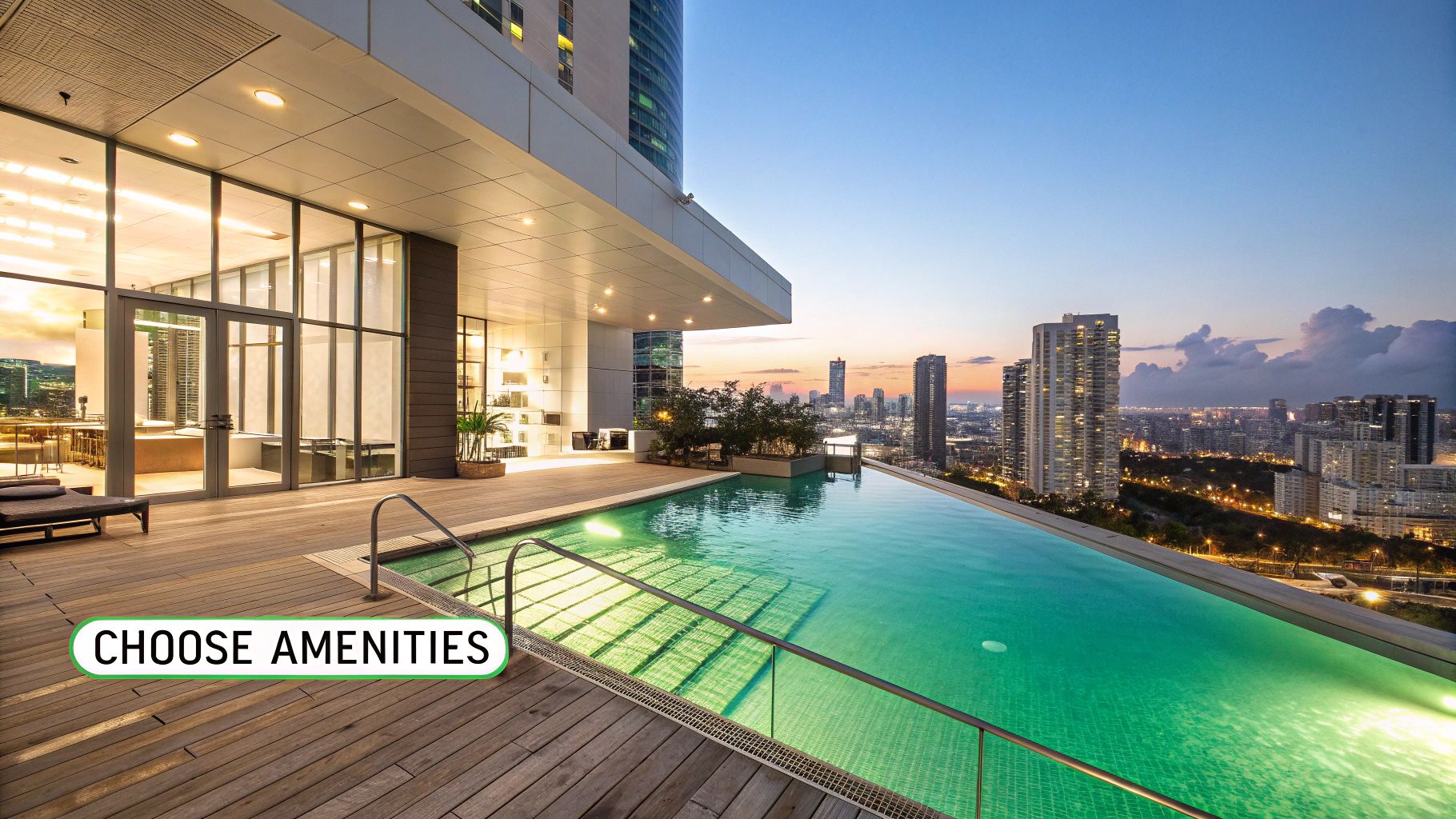
When you're hunting for 1 bedroom apartments for rent in Miami, you're doing more than just finding a place to live—you're choosing a lifestyle. The amenities a building offers are what will shape your day-to-day life. And in Miami, the options run the gamut from absolute must-haves to over-the-top luxury perks.
It's a lot like buying a car. You know you need an engine and wheels to get from A to B, but what about the panoramic sunroof or the high-end sound system? The key is to separate your true "must-haves" from the "nice-to-haves." This way, you avoid paying a premium for extras you'll barely touch.
The Non-Negotiable Miami Must-Haves
Let's be real—some amenities in South Florida aren't just for comfort; they're for survival. These are the things that should be at the absolute top of your checklist. If you overlook them, you could be setting yourself up for daily headaches and surprise expenses later on.
Here are the practical essentials you really need to look for:
- Central Air Conditioning: This is not a suggestion. Miami’s heat and humidity are relentless, and trying to get by with window units is a losing battle. They're often loud, inefficient, and will make your electricity bill skyrocket.
- In-Unit Washer and Dryer: There are few things more soul-crushing than lugging a heavy laundry basket down to a communal laundry room or, even worse, to a laundromat. Having laundry in your own apartment is a game-changer.
- Reliable Parking: If you have a car, a guaranteed parking spot is critical. In many Miami neighborhoods, street parking is a daily competition. Without included parking, you could be adding hundreds to your monthly budget for a private garage spot.
These three things are the foundation of a sane and comfortable life in Miami. Don't just assume they come standard—always ask and get it in writing before you fall in love with a place.
Valuing the Luxury Lifestyle Perks
Okay, once your basic needs are met, you can start daydreaming about the fun stuff—the glamorous amenities that give Miami living its reputation. These are the features that make an apartment building feel more like a private resort. But be warned, they also make the rent go up.
This is where you have to be brutally honest with yourself about your habits. Is paying an extra $300 a month for a building with a top-of-the-line gym worth it? It is, but only if you actually cancel your current $80 gym membership and go use it.
Think about the real-world value of these popular luxury add-ons:
- Resort-Style Pool: It looks incredible in the pictures, but will you really spend your weekends lounging there? Or are you more of a beach person?
- Rooftop Lounge or Terrace: The views are amazing, and it's a great spot for hosting friends. But if you're not the entertaining type, you might only go up there once or twice.
- 24/7 Concierge Service: For anyone who travels a lot or gets a ton of packages, a concierge is a lifesaver. They provide security and make sure your deliveries are safe.
- State-of-the-Art Fitness Center: A great on-site gym can save you money and a commute. Before you commit, take a look at the equipment and try to see how busy it gets around the time you'd be working out.
The goal is to find that sweet spot where the amenities you're paying for actually improve your daily routine. An unused amenity isn't a perk; it's just an extra line item on your rent that could be money in your pocket.
Creating Your Personal Amenity Checklist
To keep from being dazzled by a fancy feature you'll never use, make a simple checklist before you start your apartment tours. This little tool helps you stay focused and compare properties without getting distracted. Just create two columns.
My Amenity Checklist
| Must-Haves (Non-Negotiable) | Nice-to-Haves (Willing to Compromise) |
|---|---|
| Central Air Conditioning | Rooftop Lounge with Ocean Views |
| In-Unit Laundry | Resort-Style Swimming Pool |
| Dedicated Parking Spot | On-Site Dog Park |
| Pet-Friendly Policy | 24/7 Concierge or Security |
| Modern Kitchen Appliances | Community Grilling Stations |
By making this list and sticking to it, you can walk into any 1 bedroom apartment for rent in Miami with confidence. It’s the best way to make sure you find a home with perks that actually fit your life and give you real value for your money.
Your Action Plan for Finding an Apartment
Alright, we’ve covered a lot of ground. Now it’s time to take all that knowledge and turn it into a concrete plan of action. Finding the right 1 bedroom apartments for rent in Miami is a process, and like any big project, a clear strategy makes all the difference.
Think of it like packing for a vacation. You wouldn't just toss random things in a suitcase and head to the airport. You'd check the weather, make a list, and get organized. The same goes for your apartment hunt—showing up prepared is half the battle.
Your Final Pre-Launch Checklist
In a market as fast-paced as Miami’s, being ready to act is your biggest advantage. Before you start booking any tours, double-check this list. It’ll ensure you can jump on a great opportunity the second it appears.
-
Lock in Your Budget: Go back to your numbers one last time. Settle on a firm, all-in monthly figure that covers rent, utilities, parking, and those sneaky amenity fees.
-
Get Your Documents in Order: Create a folder (digital and physical) with your pay stubs, a copy of your photo ID, and contact info for your references. Having this ready to go means you can apply on the spot.
-
Clarify Your Non-Negotiables: Review your list of must-haves versus nice-to-haves. Knowing exactly what you can't live without keeps you focused and helps you avoid getting distracted by a fancy gym you'll never use.
In the Miami rental game, success is all about preparation meeting opportunity. Finding a place you love and being able to apply for it immediately puts you leagues ahead of the competition.
Once your budget is set, your documents are compiled, and your priorities are clear, you've officially shifted from a casual browser to a serious applicant.
To get the most out of your search, it's smart to use a mix of resources. You can find some great rundowns on the best apartment finding sites to help you uncover hidden gems and streamline the whole process.
You're officially ready to start. With this strategic approach, finding a one-bedroom apartment you'll be excited to call home is more than just a possibility—it's right around the corner. Happy hunting
Your Top Questions About Renting in Miami, Answered
Jumping into the search for 1 bedroom apartments for rent in Miami always brings up a few practical questions. You can have a perfect plan, but it's the little details that often pop up right when you're ready to make a move. Let's clear up some of the most common things renters ask so you can feel confident.
What's the Best Time to Look for an Apartment?
You’ll find that Miami's rental market is buzzing all year long, so there's never really a bad time to look. That said, you might find a slight advantage during the "off-season," which typically runs from May through September.
With the winter crowds gone, you'll often see more apartments become available. Some landlords might even be a little more eager to fill their spots during these hotter summer months. But don't wait around—the best apartments get claimed fast no matter the season. The real secret is to have all your paperwork in order and be ready to act when you find the right place.
How Much Is a Typical Security Deposit?
Plan on putting down one month's rent for your security deposit. That's the standard practice across Miami and what you should expect to pay.
However, don't be surprised if some landlords ask for more, especially in a competitive neighborhood or if your credit isn't spotless. It’s pretty common to be asked for the first month's rent, last month's rent, and the security deposit all at once. For an apartment that costs $2,500 a month, that means coming to the table with $7,500 right when you sign the lease.
What Income Do I Need to Rent an Apartment?
Just about every landlord in Miami lives by the "3x rule." It’s a simple formula: your gross monthly income (what you make before taxes) needs to be at least three times the monthly rent.
For example, to comfortably qualify for a one-bedroom apartment renting for $2,500 per month, your household would need to show a minimum pre-tax income of $7,500 per month, which translates to an annual salary of $90,000.
This gives them peace of mind that you can easily cover rent without stretching your budget too thin.
What Are Common Rental Scams to Avoid?
Miami's popular market is, unfortunately, a magnet for scammers. The biggest piece of advice? If a deal looks too good to be true—like a luxury Brickell high-rise for a bargain price—it probably is.
Keep an eye out for these classic red flags:
- Pressure to pay upfront: Never, ever send money for a deposit or fee on an apartment you haven't seen with your own eyes.
- Vague listings: Scammers often use stock photos and generic, copy-pasted descriptions.
- Requests for wire transfers: A legitimate property manager will have a professional and secure way for you to pay.
Always double-check who you're dealing with, and trust your gut. Once you're all moved into your new 1-bedroom apartment, you'll want to make it feel like your own. Check out these renter-friendly curtain hanging methods to personalize your space without risking your security deposit.
At Cynthia Gardens, we believe your rental experience should be smooth and straightforward. If you're looking for a peaceful community with spacious apartments in the South Florida area, we invite you to see what we offer in Boca Raton. Learn more about our available units at CynthiaGardens.com.
